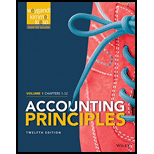
Concept explainers
(a)
(1)
Subsidiary ledger: Subsidiary ledger is a group of accounts which are similar in nature where individual balances are recorded. This is an expansion of the general ledger. The subsidiary ledger records the individual balances and hence there is no need to record the individual balances in the general ledger.
To Explain: Posting in subsidiary accounts and general ledger control accounts.
2.
Control accounts: The account which represents a summary of the subsidiary ledger account is called as the control account. It relates the general ledger and the subsidiary ledger.
To Explain: Posting in subsidiary accounts and general ledger control accounts.
(b)
To Explain: The relationship between control account and subsidiary ledger.
Want to see the full answer?
Check out a sample textbook solution
Chapter 7 Solutions
Accounting Principles, Volume 1: Chapters 1 - 12
- I am searching for the accurate solution to this general accounting problem with the right approach.arrow_forwardNeed Help About this Financial Accounting Question With Correct Answer..arrow_forwardPlease provide the correct answer to this general accounting problem using valid calculations.arrow_forward
- I need help solving this general accounting question with the proper methodology.arrow_forwardNo AI The accounting principle that requires matching revenues with related expenses is the:A. Going Concern PrincipleB. Matching PrincipleC. Cost PrincipleD. Full Disclosure Principlearrow_forwardRevenue is recognized in the accounting records when it is:A. CollectedB. EarnedC. DepositedD. Reportedarrow_forward
- The accounting principle that requires matching revenues with related expenses is the:A. Going Concern PrincipleB. Matching PrincipleC. Cost PrincipleD. Full Disclosure Principlearrow_forwardWhich account is a contra-asset?A. Accounts PayableB. Accumulated DepreciationC. Notes ReceivableD. Prepaid Rentneedarrow_forwardIf cash is received before services are provided, what is the journal entry?A. Debit Revenue, Credit CashB. Debit Unearned Revenue, Credit CashC. Debit Cash, Credit Unearned RevenueD. Debit Accounts Receivable, Credit RevenueCorrectarrow_forward
- If cash is received before services are provided, what is the journal entry?A. Debit Revenue, Credit CashB. Debit Unearned Revenue, Credit CashC. Debit Cash, Credit Unearned RevenueD. Debit Accounts Receivable, Credit Revenuecorrectarrow_forwardGAP Corp. is a calendar year S corporation with three shareholders. George and Anna each own 49 percent of the stock. Peter owns 2 percent of the stock. The corporation was formed on January 2, Year 1, and has been an S corporation since its inception. Using the exhibits, prepare a schedule of GAP's income, gain, loss, and deduction items for Year 2. In column B, enter the amount for federal income tax purposes. In column C, enter the amount included in GAP's Form 1120S ordinary business income (OBI) or loss. In column D, enter the amount included on GAP's Schedule K as a taxable or deductible separately stated item. Each item may have amounts entered in ordinary business income, separately stated items, or both. Enter income and gain amounts as positive numbers. Enter losses and deductions as negative numbers. If the amount is zero, enter a zero (0). A B C D 1 Income, Gain, Loss, and Deduction Items Amount for Federal Income Tax Purposes Ordinary Business Income…arrow_forwardIf cash is received before services are provided, what is the journal entry?A. Debit Revenue, Credit CashB. Debit Unearned Revenue, Credit CashC. Debit Cash, Credit Unearned RevenueD. Debit Accounts Receivable, Credit Revenue need helparrow_forward

 AccountingAccountingISBN:9781337272094Author:WARREN, Carl S., Reeve, James M., Duchac, Jonathan E.Publisher:Cengage Learning,
AccountingAccountingISBN:9781337272094Author:WARREN, Carl S., Reeve, James M., Duchac, Jonathan E.Publisher:Cengage Learning, Accounting Information SystemsAccountingISBN:9781337619202Author:Hall, James A.Publisher:Cengage Learning,
Accounting Information SystemsAccountingISBN:9781337619202Author:Hall, James A.Publisher:Cengage Learning, Horngren's Cost Accounting: A Managerial Emphasis...AccountingISBN:9780134475585Author:Srikant M. Datar, Madhav V. RajanPublisher:PEARSON
Horngren's Cost Accounting: A Managerial Emphasis...AccountingISBN:9780134475585Author:Srikant M. Datar, Madhav V. RajanPublisher:PEARSON Intermediate AccountingAccountingISBN:9781259722660Author:J. David Spiceland, Mark W. Nelson, Wayne M ThomasPublisher:McGraw-Hill Education
Intermediate AccountingAccountingISBN:9781259722660Author:J. David Spiceland, Mark W. Nelson, Wayne M ThomasPublisher:McGraw-Hill Education Financial and Managerial AccountingAccountingISBN:9781259726705Author:John J Wild, Ken W. Shaw, Barbara Chiappetta Fundamental Accounting PrinciplesPublisher:McGraw-Hill Education
Financial and Managerial AccountingAccountingISBN:9781259726705Author:John J Wild, Ken W. Shaw, Barbara Chiappetta Fundamental Accounting PrinciplesPublisher:McGraw-Hill Education





